-
RESEARCH01-01-2017
Promoting oral care in the preschool child: effects of a playful learning intervention
Revista Brasileira de Enfermagem. 2017;70(3):519-525
Abstract
RESEARCHPromoting oral care in the preschool child: effects of a playful learning intervention
Revista Brasileira de Enfermagem. 2017;70(3):519-525
DOI 10.1590/0034-7167-2016-0237
Views0See moreABSTRACT
Objective:
To compare the number of appropriate behaviors for tooth brushing before and after a playful learning intervention with preschool children.
Method:
A quasi-experimental, quantitative, before and after study design was conducted in an early childhood educational institution, with children between three and five years of age. The intervention consisted of three meetings with educational activities about tooth brushing, whose outcome was evaluated by means of observation of ten behaviors suitable for tooth brushing.
Results:
Forty-four children participated in the study. The mean of adequate behaviors was 4.4 before the intervention, and 8.5 after the intervention. A significant increase in the adoption of appropriate behaviors for tooth brushing (p <0.01) was identified.
Conclusion:
Nurses can enhance oral health promotion actions with preschoolers in preschool institution using playful learning interventions
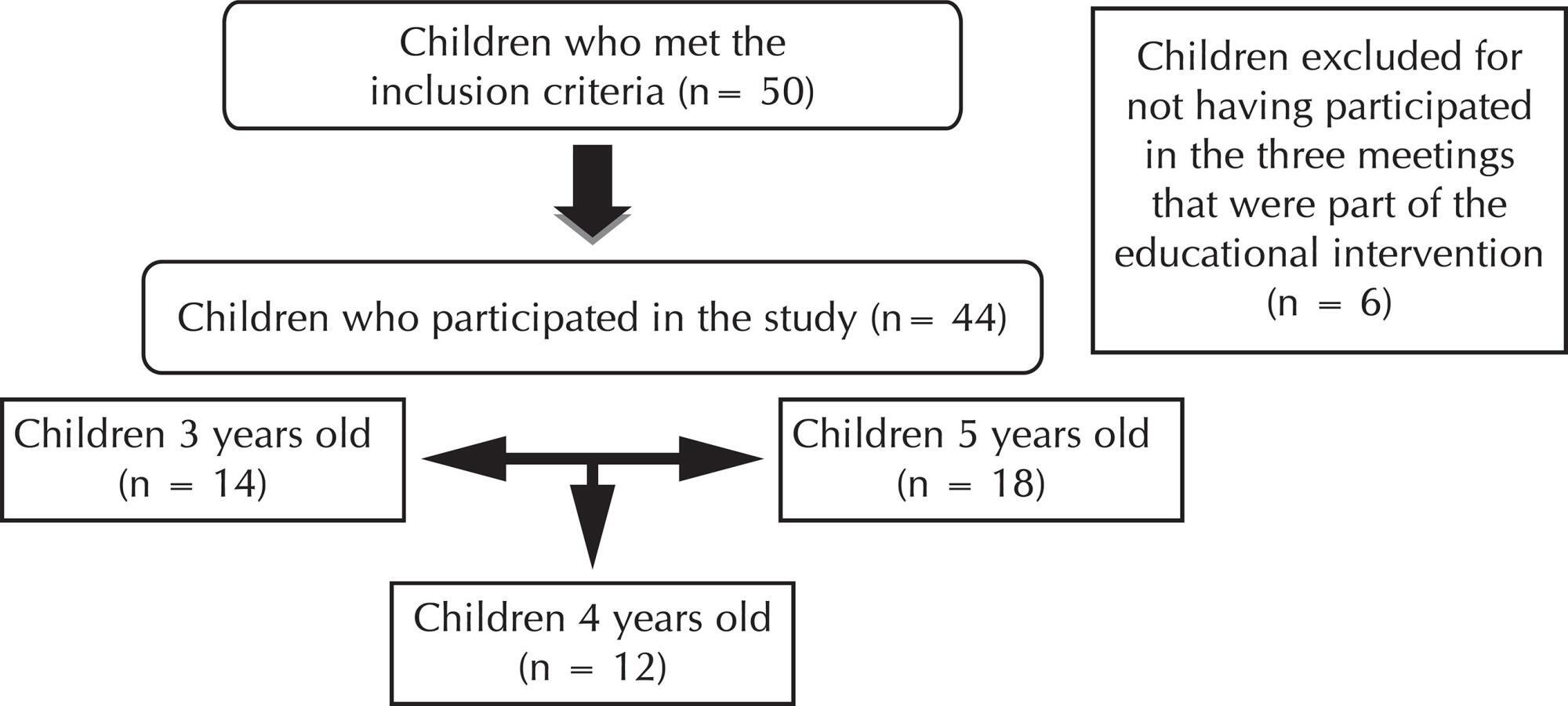
-
RESEARCH01-01-2017
Violence against children and adolescents: the perspective of Primary Health Care
Revista Brasileira de Enfermagem. 2017;70(3):511-518
Abstract
RESEARCHViolence against children and adolescents: the perspective of Primary Health Care
Revista Brasileira de Enfermagem. 2017;70(3):511-518
DOI 10.1590/0034-7167-2016-0471
Views0See moreABSTRACT
Objective:
To analyze the care provided by Basic Health Units (BHU) to families involved in domestic intrafamily violence against children and adolescents.
Method:
Qualitative research, based on the Paradigm of Complexity. Data collection was performed with 41 professionals through focus groups and semi-structured interviews.
Results:
The following categories emerged from data analysis: ‘Everything comes here’, which reflects the legitimate place of BHUs for the population and the actions taken to build care for families; and ‘We only do what is really necessary’, which brings the look to violence still based on the positivist and biomedical paradigm.
Final considerations:
The model of understanding and construction of work processes in the BHU is structured in the aforementioned paradigm. Nurses have the possibility to become agents of change, both in professionals’ training and in the care thought and provided to communities.
-
RESEARCH01-01-2017
Integrality of care: challenges for the nurse practice
Revista Brasileira de Enfermagem. 2017;70(3):504-510
Abstract
RESEARCHIntegrality of care: challenges for the nurse practice
Revista Brasileira de Enfermagem. 2017;70(3):504-510
DOI 10.1590/0034-7167-2016-0380
Views0See moreABSTRACT
Objective:
to understand the role of the nurse in the collegiate management model of a teaching hospital, in the integrality of care perspective.
Method:
a single case study with multiple units of analysis, with the theoretical proposition “integrality of care is a result of the care offered to the user by multiple professionals, including the nurse”. Data were obtained in a functional unit of a teaching hospital through interviews with 13 nurses in a non-participant observation and document analysis.
Results:
from the analytical categories emerged subcategories that allowed understanding that the nurse promotes integrality of care through nursing management, team work and integration of services.
Final considerations:
the theoretical proposition was confirmed and it was verified that the nursing management focus on attending to health care needs and is a strategy to provide integrality of care.
-
RESEARCH01-01-2017
Low completion rate of hepatitis B vaccination in female sex workers
Revista Brasileira de Enfermagem. 2017;70(3):489-494
Abstract
RESEARCHLow completion rate of hepatitis B vaccination in female sex workers
Revista Brasileira de Enfermagem. 2017;70(3):489-494
DOI 10.1590/0034-7167-2016-0567
Views0See moreABSTRACT
Objective:
to assess predictive factors for noncompletion of the hepatitis B vaccination schedule in female sex workers in the city of Teresina, Northeastern Brazil.
Method:
402 women were interviewed and, for those who did not wish to visit specialized sites, or did not know their hepatitis B vaccination status, the vaccine was offered at their workplaces. Bi- and multivariate analyses were performed to identify potential predictors for noncompletion of the vaccination schedule.
Results:
of the 284 women eligible for vaccination, 258 (90.8%) received the second dose, 157/258 (60.8%) and 68/258 (26.3%) received the second and third doses, respectively. Working at clubs and consuming illicit drugs were predictors for noncompletion of the vaccination schedule.
Conclusion:
the high acceptability of the vaccine’s first dose, associated with low completion rates of the vaccination schedule in sex workers, shows the need for more persuasive strategies that go beyond offering the vaccine at their workplaces.
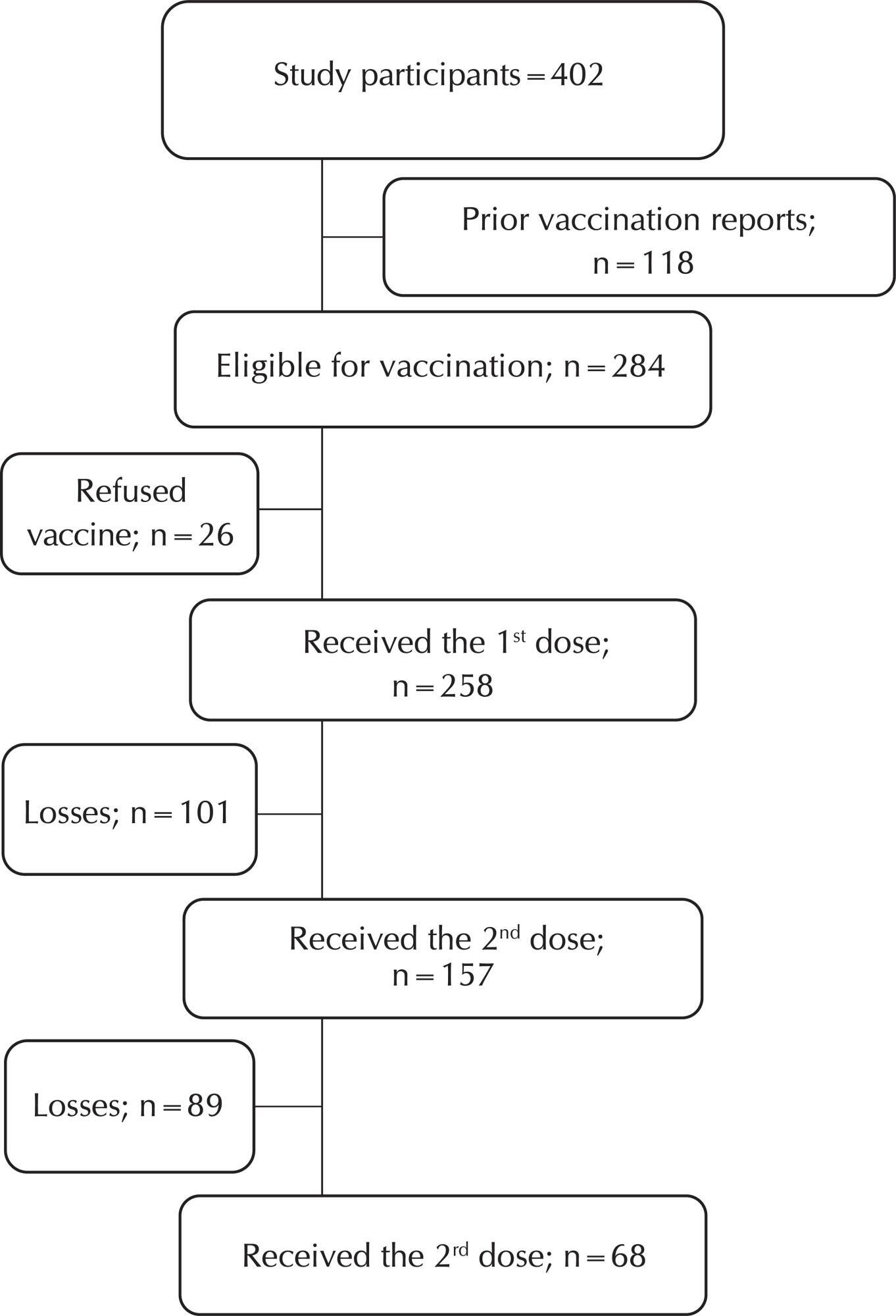
-
RESEARCH01-01-2017
Cost of nursing most frequent procedures performed on severely burned patients
Revista Brasileira de Enfermagem. 2017;70(3):481-488
Abstract
RESEARCHCost of nursing most frequent procedures performed on severely burned patients
Revista Brasileira de Enfermagem. 2017;70(3):481-488
DOI 10.1590/0034-7167-2015-0034
Views0See moreABSTRACT
Objective:
to identify the mean direct cost (MDC) of the most frequent procedures performed by nursing professionals on severely burned patients in an Intensive Care Unit.
Method:
exploratory-descriptive quantitative single-case study. The MDC was calculated by multiplying time (timed) spent by nursing professionals in the performance of the procedures by the unit cost of direct labor, and adding the costs of material and medicine/solutions.
Results:
a MDC of US$ 0.65 (SD=0.36) was obtained for “vital signs monitoring”; US$ 10.00 (SD=24.23) for “intravenous drug administration”; US$ 5.90 (SD=2.75) for “measurement of diuresis”; US$ 0.93 (SD=0.42) for “capillary blood glucose monitoring”; and US$ 99.75 (SD=129.55) for “bandaging”.
Conclusion:
the knowledge developed can support managerial decision-making, contribute to the efficiency distribution of the resources involved and, when possible, provide cost-containment or cost-minimization strategies without impairing the quality of nursing care.
-
RESEARCH01-01-2017
Nursing Activities Score and Acute Kidney Injury
Revista Brasileira de Enfermagem. 2017;70(3):475-480
Abstract
RESEARCHNursing Activities Score and Acute Kidney Injury
Revista Brasileira de Enfermagem. 2017;70(3):475-480
DOI 10.1590/0034-7167-2016-0266
Views0See moreABSTRACT
Objective:
to evaluate the nursing workload in intensive care patients with acute kidney injury (AKI).
Method:
A quantitative study, conducted in an intensive care unit, from April to August of 2015. The Nursing Activities Score (NAS) and Kidney Disease Improving Global Outcomes (KDIGO) were used to measure nursing workload and to classify the stage of AKI, respectively.
Results:
A total of 190 patients were included. Patients who developed AKI (44.2%) had higher NAS when compared to those without AKI (43.7% vs 40.7%), p <0.001. Patients with stage 1, 2 and 3 AKI showed higher NAS than those without AKI. A relationship was identified between stage 2 and 3 with those without AKI (p = 0.002 and p <0.001).
Conclusion:
The NAS was associated with the presence of AKI, the score increased with the progression of the stages, and it was associated with AKI, stage 2 and 3.
-
RESEARCH01-01-2017
Nursing appointment and cardiometabolic control of diabetics: a randomized clinical trial
Revista Brasileira de Enfermagem. 2017;70(3):468-474
Abstract
RESEARCHNursing appointment and cardiometabolic control of diabetics: a randomized clinical trial
Revista Brasileira de Enfermagem. 2017;70(3):468-474
DOI 10.1590/0034-7167-2016-0352
Views0See moreABSTRACT
Objective:
to verify the effect of nursing appointment on cardiometabolic profile of people with Diabetes Mellitus type 2.
Method:
randomized controlled trial, developed with 134 individuals chosen for two groups: intervention and control. The intervention consisted of three nursing appointments alternated bimonthly, with two phone calls, over five months. The control group received usual care offered by the Health Unit. Data were collected through semi-structured interviews before and after the intervention, in addition to conducting laboratory tests.
Results:
after the intervention, a significant difference was shown in the amount of glycated hemoglobin (p = 0.006) and in the systolic blood pressure (p = 0.031), which were higher in the control group.
Conclusion:
besides being low-cost and easy to develop on the monitoring routine of people with diabetes, the intervention performed influenced positively the biochemical profile.
-
RESEARCH01-01-2017
Terms of the specialized nursing language for the care of ostomates
Revista Brasileira de Enfermagem. 2017;70(3):461-467
Abstract
RESEARCHTerms of the specialized nursing language for the care of ostomates
Revista Brasileira de Enfermagem. 2017;70(3):461-467
DOI 10.1590/0034-7167-2015-0058
Views0See moreABSTRACT
Objectives:
to identify terms of the specialized nursing language for the care of ostomates from the literature of the area, and to map the identified terms with terms of the International Classification for Nursing Practice (ICNP®).
Method:
descriptive study of quantitative approach guided by the guidelines for the elaboration of terminology subsets of the ICNP®. The terms were collected in 49 scientific articles, extracted using a computational tool, selected according to the relevance for the theme, and normalized and mapped with the ICNP®.
Results:
20,668 terms were extracted. The standardization process resulted in 425 relevant terms (151 were constant in ICNP® and 274 were not contained in ICNP®), of which 154 were similar, 19 were more comprehensive, 50 were more restricted, and 51 were not in concordance.
Conclusion:
the use of standardized language can minimize the ambiguities and redundancies identified in the mapping. The existence of terms not in concordance with the ICNP® reinforces the need for constant updating of this classification.
-
REVIEW06-10-2022
Self-inflicted violence and suicide in people living with HIV/AIDS: a systematic review
Revista Brasileira de Enfermagem. 2022;75:e20210768
Abstract
REVIEWSelf-inflicted violence and suicide in people living with HIV/AIDS: a systematic review
Revista Brasileira de Enfermagem. 2022;75:e20210768
DOI 10.1590/0034-7167-2021-0768
Views0See moreABSTRACT
Objectives:
to analyze intellectual productions on self-inflicted violence and suicide in people living with HIV/AIDS.
Methods:
a systematic review, carried out between March and April 2021, in the PubMed®/MEDLINE®, Web of Science and LILACS databases, subsidized in the Strengthening the Reporting of Observational Studies in Epidemiology. The period outlined was from 2011 to 2020.
Results:
a total of 199 studies were identified, and 16 composed the final sample, grouped into the categories: Sociodemographic characteristics of victims of self-inflicted violence/suicide and their intervening factors (pointing to young adults, especially homosexuals, with low social support and a history of mental illness or substance abuse as usual victims); Successful measures for suicide prevention/control in people living with HIV/AIDS (suggesting more frequent psychosocial and clinical follow-up of those starting antiretroviral and immunocompromised treatment).
Conclusions:
biopsychosocial follow-up, analysis of sociodemographic profile and intervening factors should be frequent in this population for disease prevention/control.

-
ORIGINAL ARTICLE09-05-2022
Screening for common mental disorder in elderly residents in the countryside: a cross-sectional study
Revista Brasileira de Enfermagem. 2022;75:e20210875
Abstract
ORIGINAL ARTICLEScreening for common mental disorder in elderly residents in the countryside: a cross-sectional study
Revista Brasileira de Enfermagem. 2022;75:e20210875
DOI 10.1590/0034-7167-2021-0875
Views0See moreABSTRACT
Objective:
To estimate the prevalence of common mental disorders and their associated factors in the elderly in a municipality in the countryside of the Brazilian Midwest.
Methods:
Quantitative, observational, cross-sectional approach research, conducted with 218 elderly people.
Results:
The prevalence of the common mental disorder among the elderly was 25.1%; in the univariate analysis, it was higher in females (35.4%), in the age group of 80 years or older (46.1%), brown skin color (30.2%), widowed (42.6%), illiterate (47.6%), and retired (27.6%). In the multiple analysis, the variables female gender (p<0.006), age 80 years or older (p<0.036), dissatisfaction with life (p<0.009), lack of social interaction (p=0.017), and dysfunctional family (p=0.021) remained associated with CMD.
Conclusion:
The results revealed are helpful and contribute to the reinforcement of the need for mental health care in this population extract so growing worldwide.
-
ORIGINAL ARTICLE06-03-2022
Association between falls in older adults and prevention group
Revista Brasileira de Enfermagem. 2022;75:e20200207
Abstract
ORIGINAL ARTICLEAssociation between falls in older adults and prevention group
Revista Brasileira de Enfermagem. 2022;75:e20200207
DOI 10.1590/0034-7167-2020-0207
Views0See moreABSTRACT
Objectives:
to assess the effectiveness of guidelines on fall prevention in a group of older adults in Primary Health Care.
Methods:
a cross-sectional study, carried out with older adults selected by a simple random sample (274; N=1,234). Data covered sociodemographic and socioeconomic variables, marital status, health conditions, factors associated with falls and participation in the prevention group. Student’s t test was used, and dichotomous variables were used by the chi-square test. The project met ethical requirements.
Results:
sample with female profile (61.7%), married, with low education, mean age of 71.69 years. The factors associated with falls identified were female sex, medicalization and participation in the prevention group. There was no protective association between participation in a fall prevention group in older adults and a decrease in the number of falls.
Conclusions:
based on evidence, a personalized intervention during the nursing visit is suggested as a strategy to prevent falls.

-
ORIGINAL ARTICLE03-07-2022
Predictors of frailty in older people users of Primary Health Care
Revista Brasileira de Enfermagem. 2022;75:e20201292
Abstract
ORIGINAL ARTICLEPredictors of frailty in older people users of Primary Health Care
Revista Brasileira de Enfermagem. 2022;75:e20201292
DOI 10.1590/0034-7167-2020-1292
Views0See moreABSTRACT
Objective:
to identify the prevalence and predictors of frailty in older people in Primary Health Care.
Method:
this is a descriptive and correlational study, carried out in a convenience sample of 136 older people in the community. Data were collected through a sociodemographic and clinical questionnaire and frailty phenotype. Student’s t test or U-Mann-Whitney test, chi-square and binary logistic regression were used for data analysis.
Results:
the prevalence of frailty was 26.5% (n=36). Frail individuals had older age (p=0.011), worse self-rated health (p=0.001) and lower physical capacity (p<0.001). In the multivariable regression, it was observed that frail individuals had older age (Odds Ratio=1.111; 95% confidence interval=1.026-1.203) and worse physical capacity (Odds Ratio=0.673; 95% confidence interval=0.508-0.893).
Conclusions:
the prevalence of frailty in older people in Primary Health Care was considerable. Advanced age and worse physical capacity were the most relevant predictors of frailty in the elderly.
-
ORIGINAL ARTICLE04-15-2022
Validation of Questionnaire to Assess the Impact of Dementia on the Family
Revista Brasileira de Enfermagem. 2022;75:e20210232
Abstract
ORIGINAL ARTICLEValidation of Questionnaire to Assess the Impact of Dementia on the Family
Revista Brasileira de Enfermagem. 2022;75:e20210232
DOI 10.1590/0034-7167-2021-0232
Views0See moreABSTRACT
Objective:
To validate a questionnaire to assess the impact of dementia on one of the household members.
Methods:
Methodological study. The instrument was designed based on literature review, expert opinion, and researchers’ experience and then applied to a non-probability convenience sample consisting of 262 family members who live daily with a person with dementia. The construct validity was studied by exploratory factor analysis, principal components method, with varimax rotation of the items.
Results:
An instrument with 30 items was obtained, distributed in four dimensions: “Emotional dimension,” “Economic dimension,” “Family relations dimension,” and “Support-seeking dimension.” Factor analysis revealed a total explained variance of 54.96% and a total Cronbach’s alpha of .899.
Conclusions:
The instrument presents high internal consistency, grouped into four dimensions, all closely related to the family’s adaptation to the onset of dementia in one of its members.
-
ORIGINAL ARTICLE03-07-2022
Is self-esteem associated with the elderly person’s quality of life?
Revista Brasileira de Enfermagem. 2022;75:e20210388
Abstract
ORIGINAL ARTICLEIs self-esteem associated with the elderly person’s quality of life?
Revista Brasileira de Enfermagem. 2022;75:e20210388
DOI 10.1590/0034-7167-2021-0388
Views0See moreABSTRACT
Objective:
To analyze the association between self-esteem and quality of life in the elderly.
Methods:
Cross-sectional web survey developed with 519 elderly people. Participants filled out three data collection instruments developed on the Google Forms platform and widely disseminated through all of Brazil. Fisher’s exact test, Mann-Whitney, Pearson correlation, and linear regression with 95% confidence interval were used.
Results:
Self-esteem was associated with all quality-of-life facets: sensory skills [β= 1.307; p<0.001]; autonomy [β= 2.101; p<0.001]; past, present, and future activities [β= 2.486; p<0.001]; social presence [β= 2.547; p<0.001]; death and dying [β= 2.175; p<0.001]; and intimacy [β=2.378; p<0.001].
Conclusion:
There is a positive and statistically significant association between self-esteem and quality of life in the elderly. We therefore suggest the development of local policies capable of raising this age groups’ self-esteem and reaffirming aging as a new possibility for discoveries and pleasure.
-
EXPERIENCE REPORT10-24-2022
Nursing process for elderly women susceptible to falls from the perspective of the Pender’s Model
Revista Brasileira de Enfermagem. 2022;75:e20210913
Abstract
EXPERIENCE REPORTNursing process for elderly women susceptible to falls from the perspective of the Pender’s Model
Revista Brasileira de Enfermagem. 2022;75:e20210913
DOI 10.1590/0034-7167-2021-0913
Views0See moreABSTRACT
Objectives:
to describe the strategy of applying the nursing process guided by Pender’s Health Promotion Model to elderly women susceptible to falls with a view to promoting a self-efficacy behavior for fall prevention.
Methods:
application of the nursing process to eleven elderly women who had already experienced falls, living in a neighborhood in the outskirts of Belem, state of Pará, which involved interviews to obtain their nursing history and group meetings using the focus group technique to develop the other phases of the nursing process: nursing diagnosis, nursing interventions, and nursing assessment.
Results:
despite the risk factors for falls, the intervention model adopted in this study allowed elderly women to enhance their self-efficacy.
Final Considerations:
the model proved to be suitable for the participation of elderly women in actions to build fall prevention behaviors, with a view to healthier lifestyles.

-
ORIGINAL ARTICLE10-24-2022
Factors associated with symptoms of physical and emotional burden in informal caregivers of the elderly
Revista Brasileira de Enfermagem. 2022;75:e20210927
Abstract
ORIGINAL ARTICLEFactors associated with symptoms of physical and emotional burden in informal caregivers of the elderly
Revista Brasileira de Enfermagem. 2022;75:e20210927
DOI 10.1590/0034-7167-2021-0927
Views1See moreABSTRACT
Objectives:
to analyze the personal and work-related burden factors associated with physical and emotional symptoms of informal caregivers of the elderly.
Methods:
cross-sectional study conducted with 121 informal caregivers and 121 seniors who received care, assessed individually for the risk of: physical overload, musculoskeletal symptoms, Self-Reporting Questionnaire, effort perception, and Katz index.
Results:
a greater perception of effort raises up to 3.3 times the chances of presenting symptoms of pain in the spine region (p=0.01), and lower functional capacity of the elderly increases up to 1.3 times the chances of presenting pain symptoms in the spine region (p=0.02). The symptoms of emotional overload were associated with the caregiver’s low income (p=0.02).
Conclusions:
the perception of effort, dependence of the elderly, caregiver’s age, and symptoms of emotional overload are involved with caregivers’ symptoms of physical overload, and low income, with emotional overload.
-
ORIGINAL ARTICLE12-05-2019
Occurrence of violence in the elderly and its associated factors
Revista Brasileira de Enfermagem. 2019;72:64-70
Abstract
ORIGINAL ARTICLEOccurrence of violence in the elderly and its associated factors
Revista Brasileira de Enfermagem. 2019;72:64-70
DOI 10.1590/0034-7167-2018-0014
Views0See moreABSTRACT
Objective:
to analyze the occurrence of violence in the elderly and its associated factors in the city of Betim, Minas Gerais.
Method:
cross-sectional study constituted by a population survey conducted through structured interviews. The sample was stratified by clusters and included 178 elderly people at the end. Data were analyzed by the chi-square test and was performed a Correspondence Analysis.
Results:
The most prevalent forms of violence were: lack of access to social rights (31%), verbal violence (22%), moral/psychological (19%), lack of care (16%), physical violence (6%), sexual (3%) and discrimination (3%). Women suffered more abuse than men and violence had greater association with the degree of depressive symptoms.
Conclusion:
our research has direct implication for the sectors interested in coping with violence in the elderly, especially for nurses, because it shows violence is part of a cycle with characteristic associated factors that conforms a model nested mainly in the family relationship.
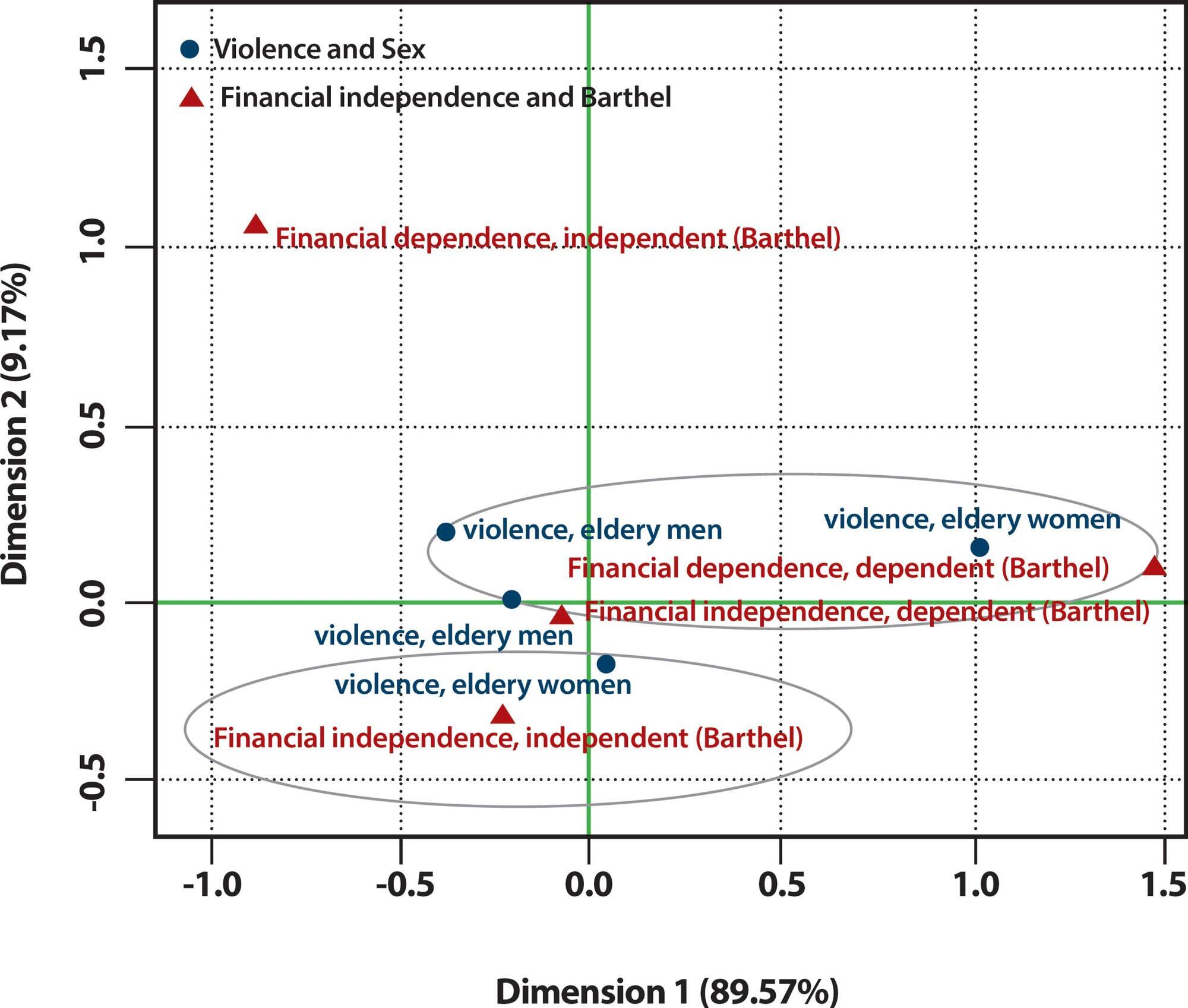
-
09-16-2019
Socioeconomic factors related to leprosy: an integrative literature review
Revista Brasileira de Enfermagem. 2019;72(5):1405-1415
Abstract
Socioeconomic factors related to leprosy: an integrative literature review
Revista Brasileira de Enfermagem. 2019;72(5):1405-1415
DOI 10.1590/0034-7167-2017-0651
Views0See moreABSTRACT
Objective:
To investigate in the literature the relation of socioeconomic factors in the incidence of the disease and other outcomes related to leprosy.
Method:
Integrative review conducted in Lilacs, Medline, Scopus databases and SciELO online library with studies from 2000 to 2016.
Results:
32 studies were included. Only studies that analyzed statistical associations of socioeconomic factors and outcomes related to leprosy were selected.
Conclusion:
Leprosy is greatly affected by the social context in which the patient is inserted, the chances of exposure to illness are the result of a set of not only individual aspects, but also of contexts or collective conditions. It is imperative for Nursing, as an essential part of the multiprofessional team entrusted with the care and surveillance of the disease, to recognize these factors to predict unfavorable outcomes and to develop new practices capable of reducing inequities.
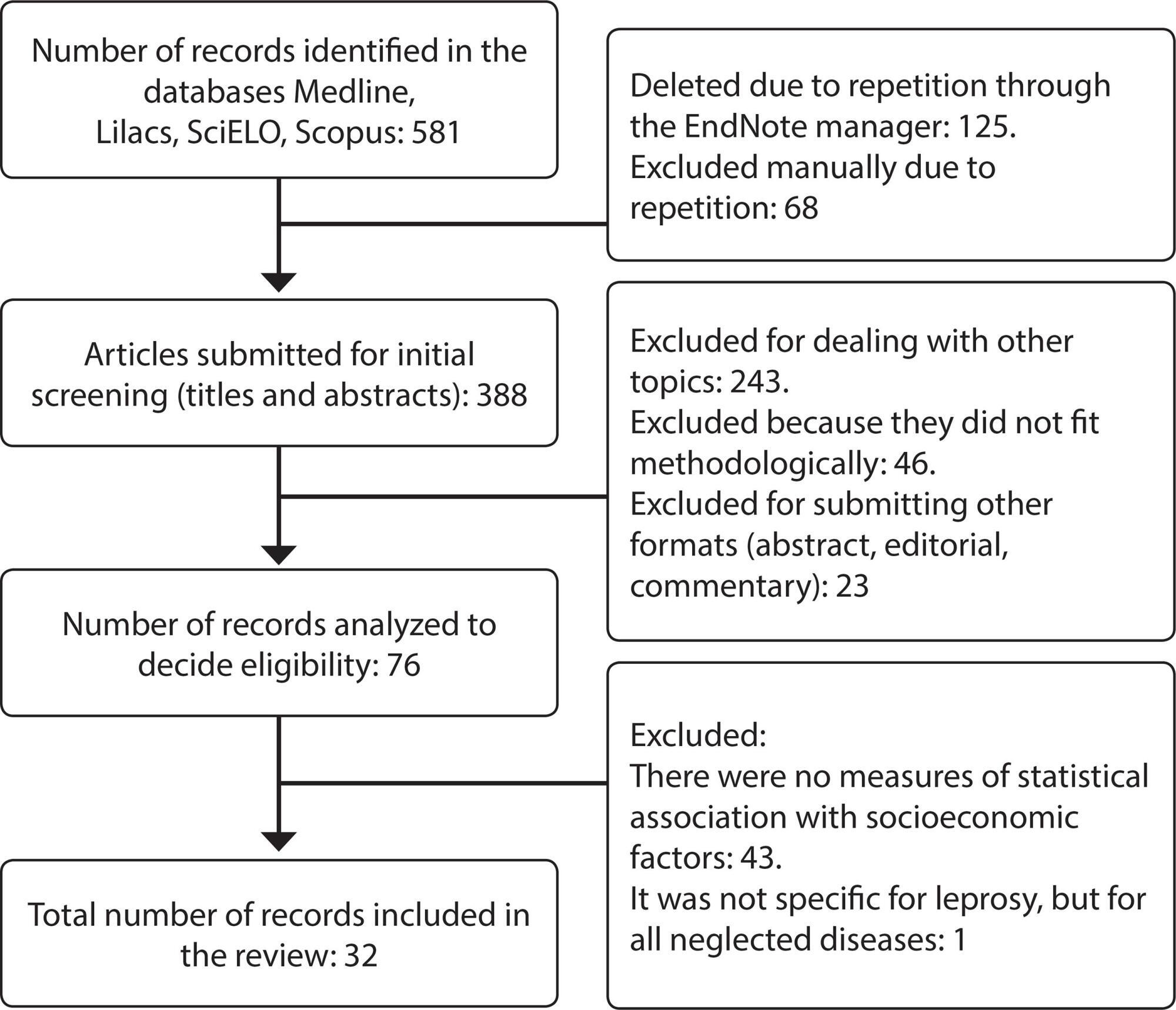
-
EXPERIENCE REPORT10-26-2020
Brazilian Nursing Process Research Network contributions for assistance in the COVID-19 pandemic
Revista Brasileira de Enfermagem. 2020;73:e20200798
Abstract
EXPERIENCE REPORTBrazilian Nursing Process Research Network contributions for assistance in the COVID-19 pandemic
Revista Brasileira de Enfermagem. 2020;73:e20200798
DOI 10.1590/0034-7167-2020-0798
Views0See moreABSTRACT
Objective:
to describe the theoretical construction process of nursing process support documents in COVID-19 care scenarios.
Methods:
an experience report of the joint activity of the Brazilian Nursing Process Research Network (Rede de Pesquisa em Processo de Enfermagem) composed of Higher Education and Health Institution researchers in Brazil.
Results:
five instruments were organized collectively, involving the elements of nursing practice (nursing diagnoses, outcomes and interventions) in assistance for community; for patients (with suspected or mild, moderate, and critical COVID-19 and residents in Nursing Homes); for nursing workers’ health support, also subsidizing registration and documentation during the COVID-19 pandemic.
Final considerations:
valuing the phenomena manifested by families/communities, patients and health professionals is essential for early detection, intervention, and prevention of diseases.
-
11-13-2020
Fear of childbirth in time of the new coronavirus pandemic
Revista Brasileira de Enfermagem. 2020;73:e20200551
Abstract
Fear of childbirth in time of the new coronavirus pandemic
Revista Brasileira de Enfermagem. 2020;73:e20200551
DOI 10.1590/0034-7167-2020-0551
Views0See moreABSTRACT
Objective:
Reflect on how the new coronavirus pandemic triggered or accentuated the fear of childbirth in pregnant women and affected childbirth care practices.
Methods:
Reflective analysis of women’s pregnancy and childbirth experiences during the current pandemic, supported by the latest scientific evidence and recommendations on the topic.
Results:
Pregnancy and childbirth are life-changing events for women, but during the new coronavirus pandemic, fear and uncertainty have taken on an unprecedented dimension in the negative way that many pregnant women have anticipated and experienced childbirth.
Final considerations:
The current period has accentuated a chronic problem: a paternalistic system of health institutions in the approach to childbirth, dense with additional levels of fear in pregnant women. In this context, addressing the fear of childbirth means not giving up the promotion of safe and positive birth experiences for women.
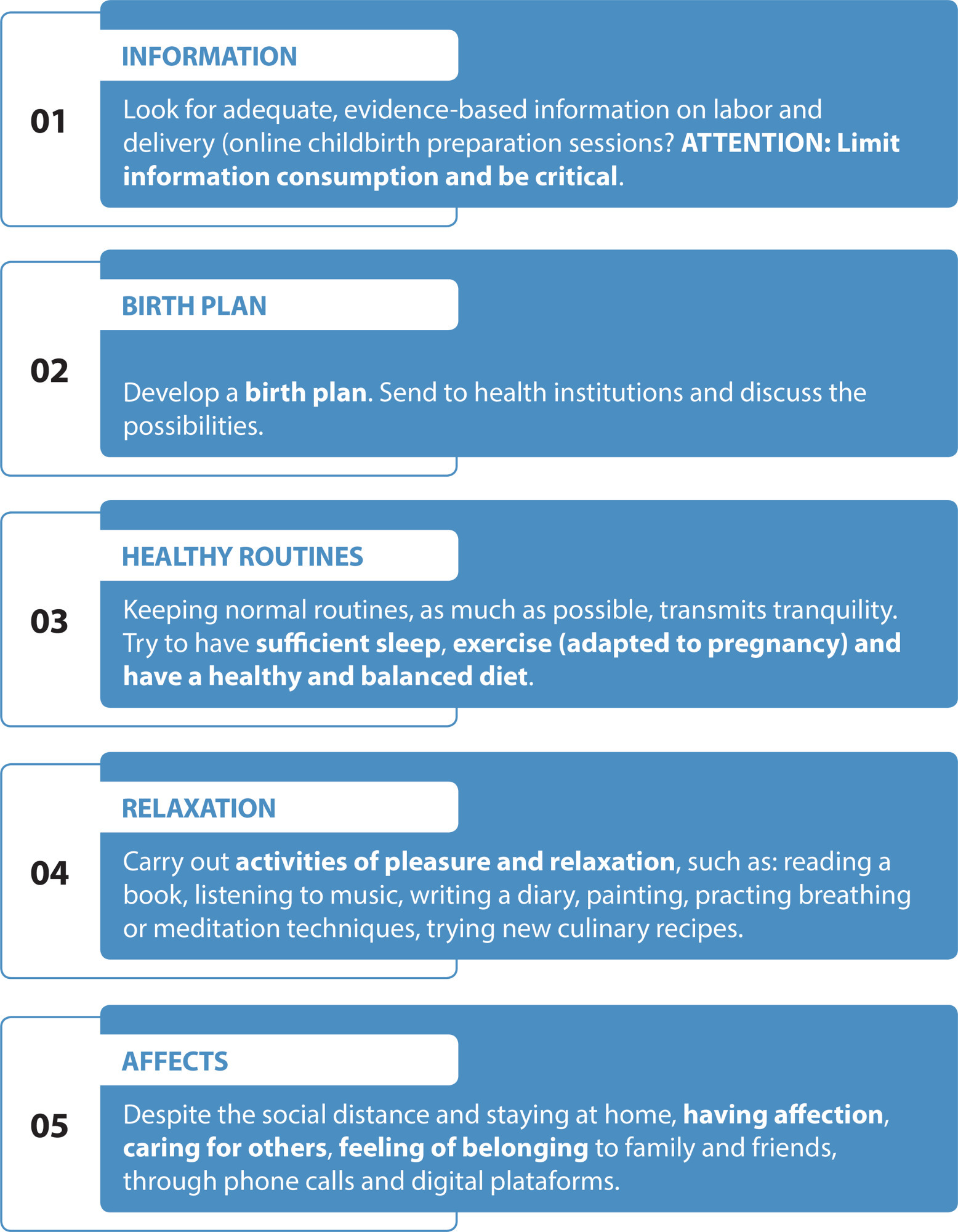
-
01-29-2021
Domestic violence against women amidst the pandemic: coping strategies disseminated by digital media
Revista Brasileira de Enfermagem. 2021;74:e20200631
Abstract
Domestic violence against women amidst the pandemic: coping strategies disseminated by digital media
Revista Brasileira de Enfermagem. 2021;74:e20200631
DOI 10.1590/0034-7167-2020-0631
Views0See moreABSTRACT
Objective:
to know the strategies to cope with domestic violence against women disseminated by digital media at the beginning of the COVID-19 pandemic.
Methods:
a documentary study with a qualitative approach. The search took place from March 11 to April 30, 2020, from four sources: newspapers and online portals, social network, official government pages and third sector portals. Thematic content analysis of the findings was performed.
Results:
seventy-seven strategies were identified in the journalistic press, 93 in the social network, 45 in government portals and 40 in third sector organizations. From analysis, three empirical categories emerged: Strategies for communication with women; Strategies adopted by customer service; Strategies to inform the population.
Final considerations:
most of strategies were adaptations of existing services, centered on the reporting of violence by women
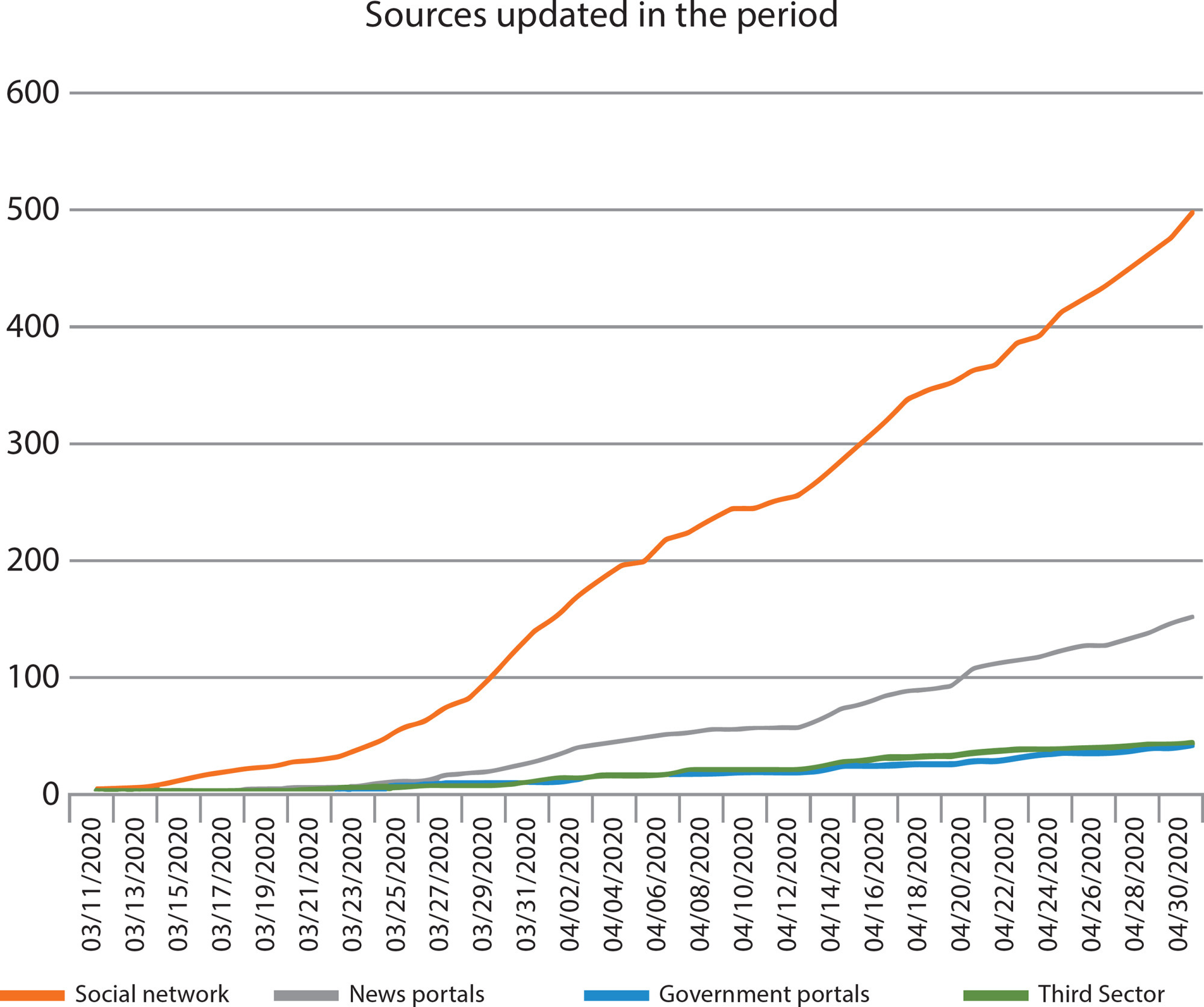
-
ORIGINAL ARTICLE03-07-2022
Is social isolation during the COVID-19 pandemic a risk factor for depression?
Revista Brasileira de Enfermagem. 2022;75:e20210594
Abstract
ORIGINAL ARTICLEIs social isolation during the COVID-19 pandemic a risk factor for depression?
Revista Brasileira de Enfermagem. 2022;75:e20210594
DOI 10.1590/0034-7167-2021-0594
Views0See moreABSTRACT
Objective:
To assess factors associated with depression among higher education students and professionals during the peak of the COVID-19 pandemic.
Method:
quantitative study with a cross-sectional design. 550 students and professionals participated. The data were collected by means of a digital questionnaire that included Patient Health Questionnaire-9 to assess depressive symptoms.
Results:
The factors related to depression and social isolation outcomes were significantly associated with the female gender (n= 149; 37,8%; Odds Ratio OR=2,0), white (n=127; 37,2%; OR=1,60), young people (n=130; 39,4%; OR=2,0), without religion (n=70; 40,2%; OR=1,64), with financial problems (n=80; 53,0%; OR=2,40) and family problems (n=98; 47,3%; OR=1,77); who suffered violence during the quarantine (n=28; 58,3%; OR=2,33), increased the use of illicit drugs (n=16; 59,3%; OR=2,69), used sedatives without a medical prescription (n=75; 54,0%; OR=2,94), lived in conflicting relationships (n=33; 54,1%;OR=2,14), lost their job during the pandemic (n=32; 59,3%; OR=1,99) and presented symptoms of anxiety related to COVID-19 (n=155; 45,2%; OR=3,91).
Conclusion:
there is a meaningful relationship between vulnerability and adopting risk behaviors during the pandemic-imposed social isolation with depressive symptoms. We suggest that health professionals be attentive to the need to adjust their psychosocial interventions when promoting strategies when promoting strategies to mitigate the effects and risks to mental health.
-
ORIGINAL ARTICLE07-08-2020
Development and validation a nursing care protocol with educational interventions for family caregivers of elderly people after stroke
Revista Brasileira de Enfermagem. 2020;73:e20180894
Abstract
ORIGINAL ARTICLEDevelopment and validation a nursing care protocol with educational interventions for family caregivers of elderly people after stroke
Revista Brasileira de Enfermagem. 2020;73:e20180894
DOI 10.1590/0034-7167-2018-0894
Views0See moreABSTRACT
Objective:
development and validation the content of a nursing care protocol with educational interventions for family caregivers of elderly people after stroke.
Methods:
a methodological study conducted in three stages: (1) protocol development through literature review; (2) pretest with multidisciplinary team, analyzed with literature articulation; (3) protocol validation by the Delphi Technique.
Results:
the protocol was structured in the following areas: Disease Guidelines; Emotional Support; Using the Health Care Network; Diet; Airways; Medications; Hygiene; Skin Care; Disposal; Dressing/Undressing; Positioning and Transfer; Fall Prevention. In the pretest, eight experts assessed protocol clarity and content. In validation, there were two rounds by the Delphi Technique. The validated protocol consisted of 12 domains, containing 42 items and 240 care guidelines.
Conclusion:
the protocol qualifies the transition of care after hospital discharge assisting nurses in home care practice.
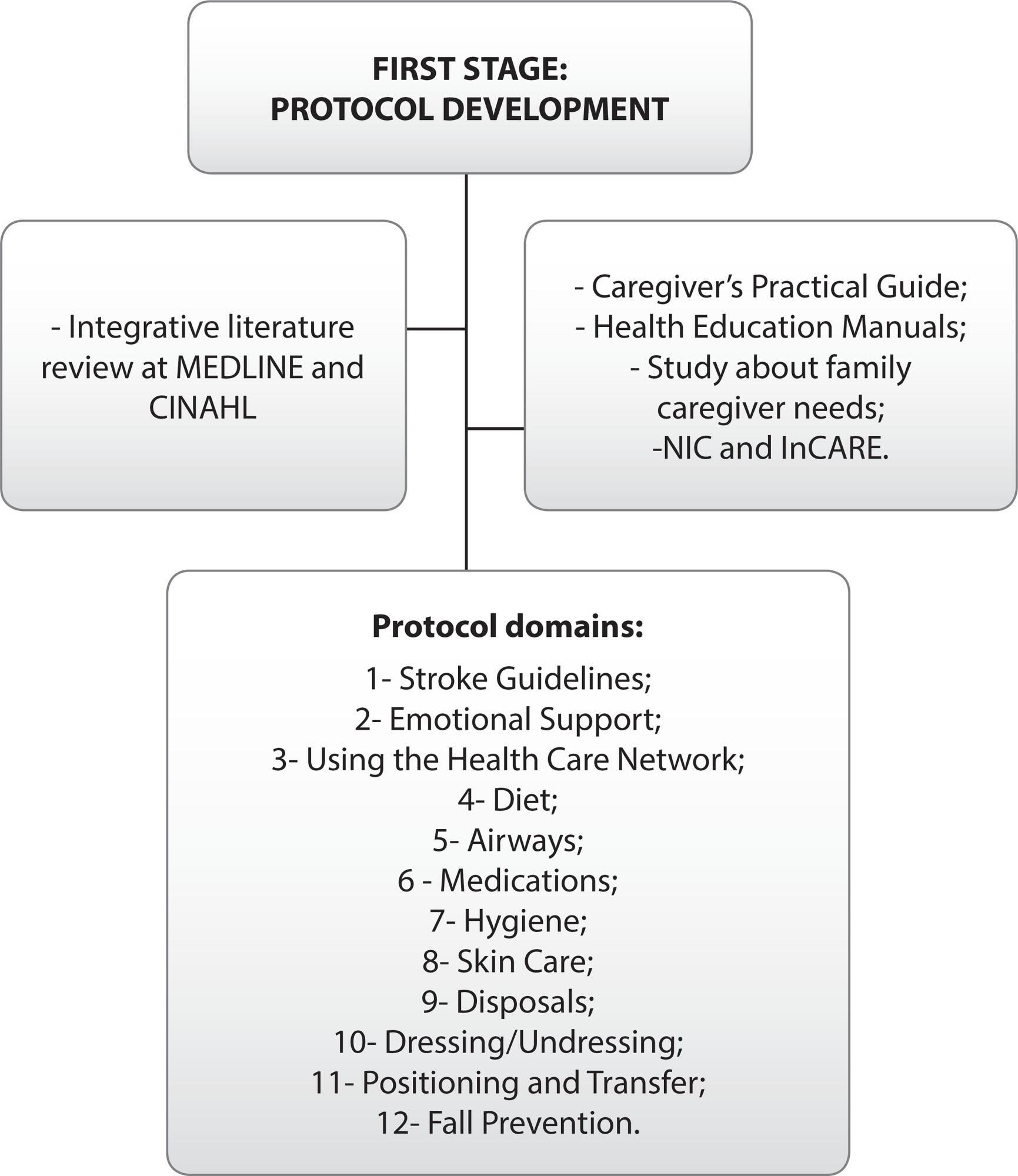
-
REVIEW04-22-2020
Polycyclic aromatic hydrocarbons and development of respiratory and cardiovascular diseases in workers
Revista Brasileira de Enfermagem. 2020;73(3):e20180965
Abstract
REVIEWPolycyclic aromatic hydrocarbons and development of respiratory and cardiovascular diseases in workers
Revista Brasileira de Enfermagem. 2020;73(3):e20180965
DOI 10.1590/0034-7167-2018-0965
Views0See moreABSTRACT
Objectives:
to identify the scientific evidence on the development of cardiovascular and respiratory diseases due to workplace contamination by polycyclic aromatic hydrocarbons.
Methods:
integrative literature review. The search for primary articles was held in October 2017 in the Medical Literature Analysis and Retrieval System Online (through Pubmed), Web of Science and Latin American and Caribbean Literature in Health Sciences (LILACS).
Results:
the 16 studies analyzed showed that exposure to polycyclic aromatic hydrocarbons was associated with cardiovascular diseases, such as increased blood pressure, heart rate variation, and ischemic heart disease; and respiratory disorders, such as decreased lung function, chronic obstructive pulmonary disease, asthma, wheeze, coughing, pulmonary wheezing, chest tightness, effort dyspnea, and sore throat.
Conclusions:
polycyclic aromatic hydrocarbons cause deleterious effects on the cardiovascular and respiratory systems through mutations and cellular inflammation, being a risk to exposed individuals.
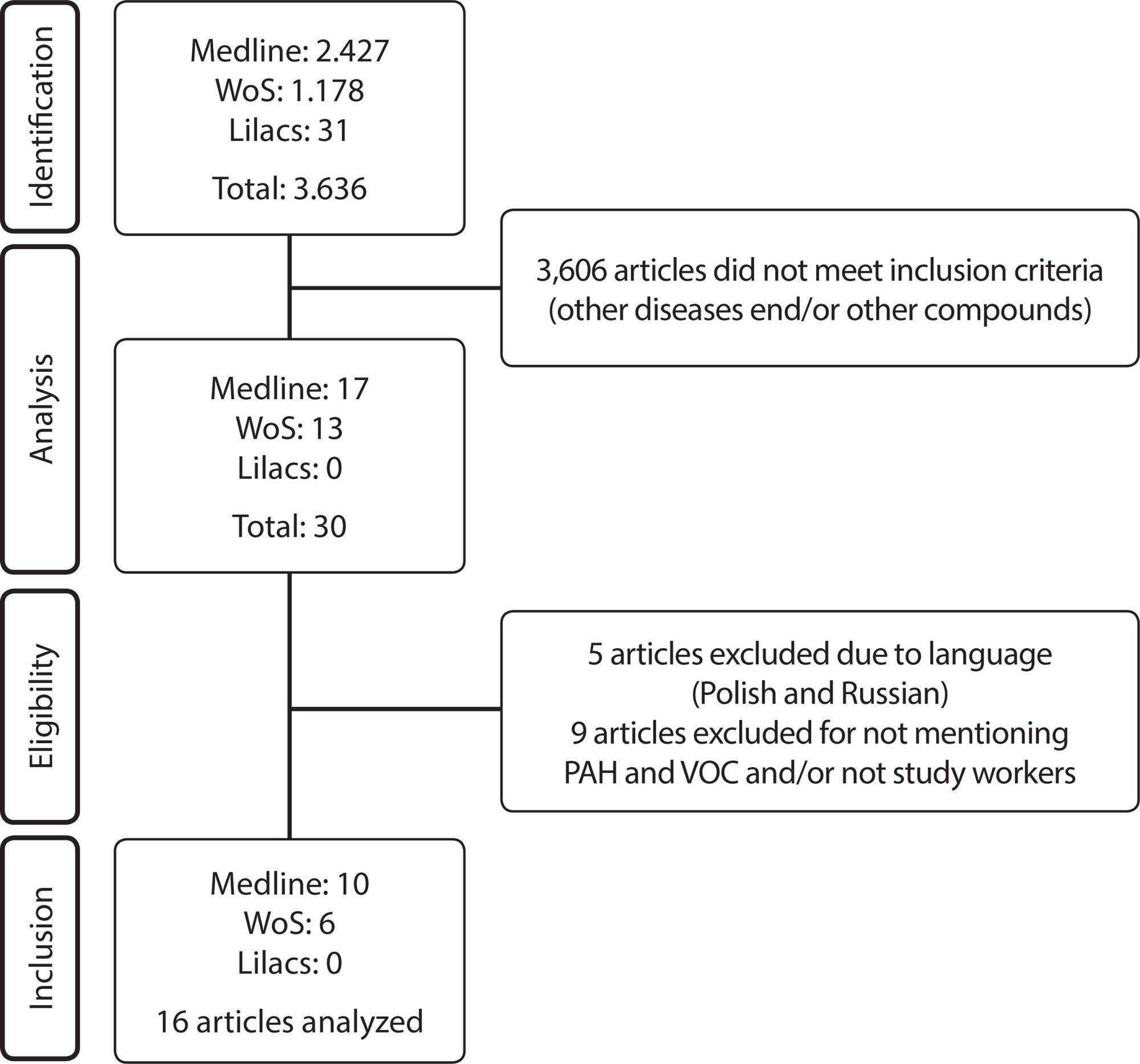
Search
Search in:
Nuvem de Tags
Adolescente (85) Atenção Primária à Saúde (239) COVID-19 (91) Criança (91) Cuidados de Enfermagem (269) Educação em Enfermagem (151) Educação em Saúde (139) Enfermagem (930) Enfermagem Pediátrica (86) Estudantes de Enfermagem (77) Estudos de Validação (131) Família (87) Idoso (208) Promoção da Saúde (99) Qualidade de Vida (104) Saúde do Trabalhador (86) Saúde Mental (145) Saúde Pública (82) Segurança do Paciente (150) Tecnologia Educacional (100)



